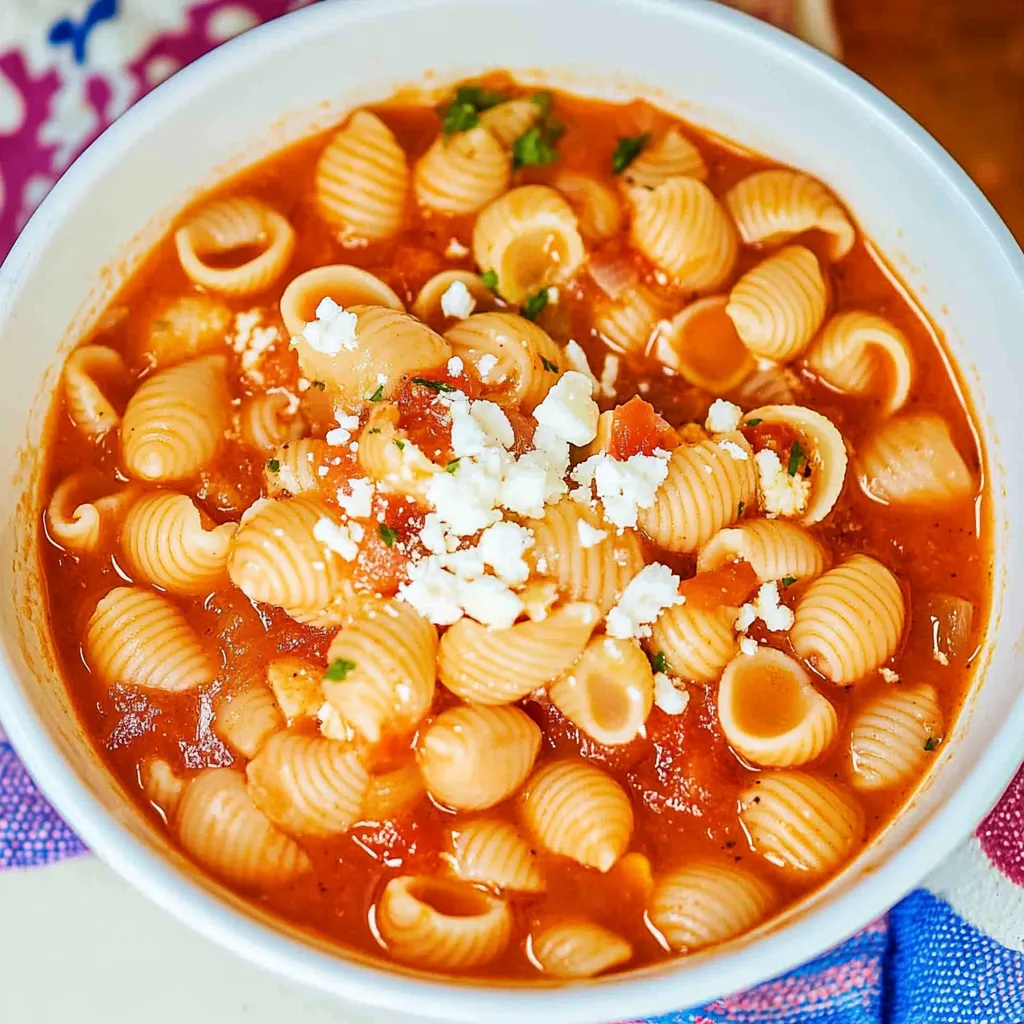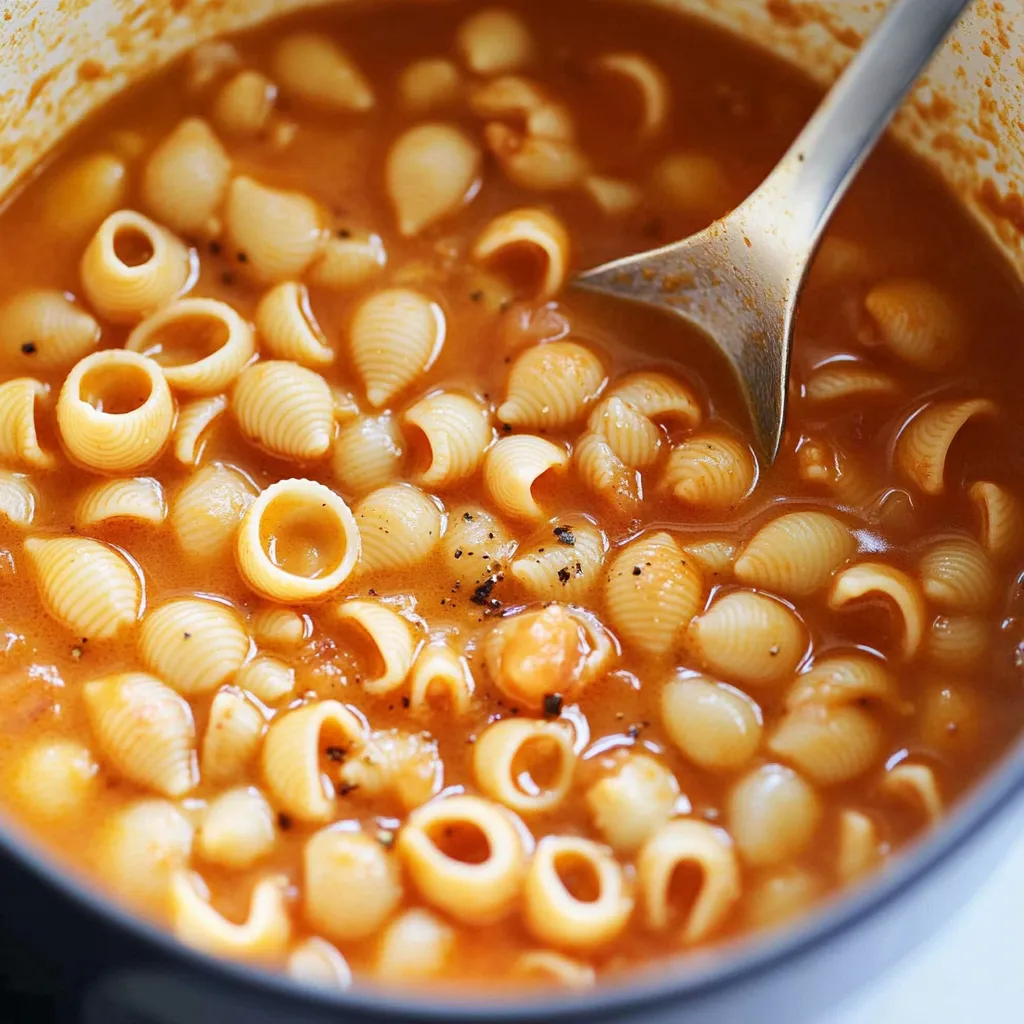 Pin it
Pin it
This comforting sopita delivers all the warmth and satisfaction of classic chicken noodle soup with a distinctive Mexican twist that transforms simple pantry ingredients into a deeply flavorful, soul-warming meal in under 30 minutes. The genius of this recipe lies in the crucial step of toasting the pasta shells before adding liquid - this technique creates nutty depth and prevents the pasta from becoming mushy while developing the rich, complex flavor that distinguishes authentic sopita from ordinary pasta soups. Unlike basic canned soups that taste flat and one-dimensional, this homemade version builds layers of flavor through proper technique and traditional seasoning combinations that create a satisfying meal capable of serving as either a light lunch or hearty dinner.
I discovered this recipe when I was looking for something that captured the comforting essence of chicken noodle soup but with more interesting flavors and textures. The first time I made it, I was amazed by how the simple step of toasting the pasta created such incredible depth, and now it's become my go-to soup when I want something that feels both familiar and special, especially during cold weather when we crave warming, satisfying meals.
Essential Ingredients and Selection Tips
- Medium pasta shells: Choose shells that will hold their shape during cooking; substitute with elbow macaroni, alphabet pasta, or vermicelli if preferred
- Quality chicken stock: Use low-sodium chicken broth for best flavor control; homemade stock creates the richest results but store-bought works perfectly
- Crushed tomatoes: Look for high-quality canned crushed tomatoes without added sugars; San Marzano varieties provide superior flavor
- Mexican oregano: This provides distinctly different flavor from Mediterranean oregano; if unavailable, use regular oregano plus a pinch of marjoram
- Fresh aromatics: Use fresh garlic and onion for best flavor; avoid pre-minced versions that lack the intensity needed for proper flavor development
- Neutral cooking oil: Use vegetable or canola oil with high smoke point for proper pasta toasting without off-flavors
The secret to authentic flavor is the toasting step - this develops nutty complexity that distinguishes sopita from ordinary pasta soups while preventing mushy texture.
Detailed Step-by-Step Instructions
- Step 1: Prepare your ingredients:
- Have all ingredients measured and ready before starting - this soup moves quickly once you begin. Mince the onion finely and crush the garlic cloves.
- Step 2: Heat oil properly:
- In a medium, heavy-bottomed pot, heat oil over medium heat until it shimmers but doesn't smoke. The right temperature is crucial for proper pasta toasting.
- Step 3: Toast pasta shells:
- Add the dry pasta shells to the hot oil and stir constantly for 3-4 minutes until they turn golden brown and smell nutty. This step is crucial and cannot be skipped.
- Step 4: Add aromatics:
- Add the minced onion to the toasted pasta and continue cooking, stirring frequently, until the onion softens and becomes translucent, about 2-3 minutes.
- Step 5: Build the base:
- Pour in the chicken stock slowly to prevent violent bubbling, then add salt, black pepper, Mexican oregano, and crushed red pepper flakes if using.
- Step 6: Add tomato component:
- Stir in the crushed tomatoes and crushed garlic cloves, mixing well to combine all ingredients evenly throughout the soup.
- Step 7: Bring to proper boil:
- Increase heat to medium-high and bring the mixture to a rolling boil, stirring occasionally to prevent sticking.
- Step 8: Simmer to perfection:
- Reduce heat to low and simmer for 10-15 minutes, stirring occasionally, until the pasta shells are tender but still hold their shape and the soup has reduced to desired consistency.
- Step 9: Check seasoning:
- Taste and adjust salt, pepper, or heat level as needed. The soup should be flavorful but not oversalted since it will concentrate slightly as it cools.
- Step 10: Serve immediately:
- Ladle into bowls while hot and offer garnishes like lime wedges, chopped cilantro, shredded cheese, or sour cream for customization.
 Pin it
Pin it
The most important technique is constant stirring during the pasta toasting phase to ensure even browning without burning, which would create bitter flavors.
This sopita has become my proof that traditional cooking techniques exist for good reasons - the extra few minutes spent toasting pasta creates flavor complexity that can't be achieved through shortcuts or convenience products.
Understanding Pasta Toasting Science and Flavor Development
The toasting process fundamentally changes pasta's flavor profile through the Maillard reaction, where proteins and sugars in the wheat undergo complex chemical changes that create hundreds of new flavor compounds. This browning reaction not only develops nutty, complex tastes but also changes the pasta's surface structure, helping it maintain better texture during the subsequent simmering process. Understanding this science explains why this step cannot be skipped or rushed.
Liquid Balance and Consistency Control
The proper ratio of pasta to liquid creates sopita's characteristic consistency - substantial enough to be satisfying but soupy enough to require a spoon. Too much pasta creates a thick, stew-like consistency, while too much liquid dilutes flavors and creates watery results. The simmering process concentrates flavors while allowing pasta to finish cooking, requiring careful attention to prevent over-reduction or under-cooking.
Tomato Integration and Acidity Balance
Crushed tomatoes provide both flavor and body to the soup while contributing natural acidity that brightens the overall taste profile. The tomatoes break down slightly during simmering, creating a cohesive broth rather than separate components. The acidity also helps balance the richness from any added proteins or cheese, creating a well-rounded flavor profile that doesn't feel heavy or one-dimensional.
Heat Building and Spice Integration
The optional crushed red pepper flakes provide customizable heat that builds gradually during simmering. Adding spices early in the cooking process allows their flavors to bloom and integrate rather than tasting sharp or raw. Mexican oregano provides earthy, slightly citrusy notes that complement rather than compete with the tomato base, creating authentic flavor profiles.
Customization Strategies and Protein Addition
The base recipe provides an excellent foundation for countless variations based on available ingredients or dietary preferences. Adding proteins like chicken, ground beef, or shrimp requires slight timing adjustments to ensure proper cooking without overcooking the pasta. Vegetables should be added based on their cooking times, with harder vegetables like carrots added earlier and delicate ones like peas added near the end.
This sopita has taught me that some of the most satisfying comfort foods come from understanding how traditional techniques enhance simple ingredients rather than relying on exotic components or complicated methods. Every time I make it, I'm reminded that the best family recipes are those that transform pantry staples into something that feels special and nourishing, creating meals that satisfy both body and soul while bringing people together around the table.
Frequently Asked Questions
- → How long does sopita take to make?
- This soup takes 25 minutes total - 5 minutes prep and 20 minutes cooking time.
- → Can I use a different pasta shape?
- Yes, small pasta shapes like elbow macaroni or ditalini work well too.
- → Why do you toast the pasta first?
- Toasting the pasta adds a nutty flavor and helps it hold its shape better in the soup.
- → Can I make this soup vegetarian?
- Sure! Just swap the chicken broth for vegetable broth to make it vegetarian.
- → How do I store leftover sopita?
- Keep leftovers in the fridge for up to 3 days. The pasta will absorb more broth as it sits.
- → What can I serve with this soup?
- Serve with warm tortillas, crusty bread, or a simple green salad on the side.
